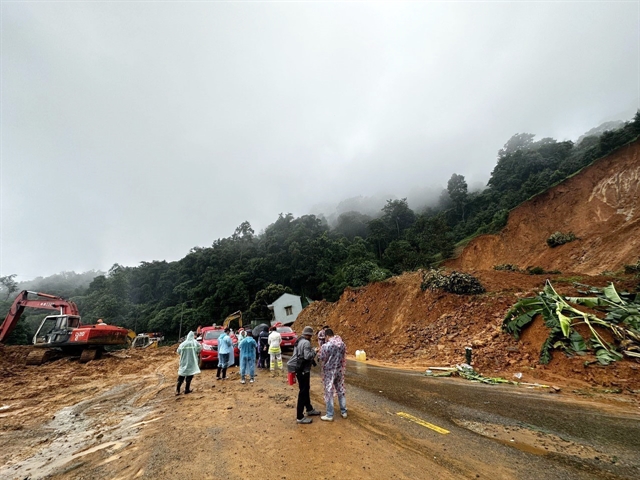 Opinion
Opinion

 |
| Dr Trần Tân Văn, former director of Việt Nam Institute of Geosciences and Mineral Resources (under the Ministry of Natural Resources and Environment). — Photo baochinhphu.vn |
Multiple cases of erosion have been recorded across the country since late June. Dr Trần Tân Văn, former director of Việt Nam Institute of Geosciences and Mineral Resources spoke to VietnamPlus e-newspaper about the causes and signs of danger and ways to minimise risks and damage.
What are the main reasons for the recent multiple landslides across the country?
There are two key reasons for the landslides across the country recently, one is the prolonged downpours that saturate the soil with water, making the slopes more unstable. The other is human activities. In fact, these have contributed to the worsening signs of instability of rock masses in steep slopes.
Research shows that a slope’s stability is often determined by three factors, which include the slope morphology (steepness, height, length, width), as well as the physical and mechanical properties of the rocks at the slope.
For example, in the Central Highlands, there is an abundance of basalt volcanic rock, which is weathered into red soil of great thickness and is porous, making it easier to be eroded and structurally destroyed when saturated with water.
The other factor is water, both surface and underground. Geologists and geoengineers often say that “water is the enemy of the slope.” In fact, water saturates rock and soil that form the slope, which reduces strength and increases the mass of a potential sliding block, which then causes a landslide.
Heavy rain that lasts many days combined with human activities makes the soil on mountain slopes saturate at a higher rate. This is the direct ‘trigger’ that causes the recent erosion and soil cracks in many cities and provinces across the country.
Regarding the recent landslide in Bảo Lộc Pass, deputy head of the National Steering Committee on Natural Disaster Prevention and Control Nguyễn Hoàng Hiệp said that this is a new lesson to learn and a new risk, as the site was not inherently at major risk or required urgent evacuation. What are your thoughts on this?
That is a correct evaluation. I believe that human activities, without calculations and consideration of possible consequences, are playing an increasingly pivotal role in causing the aforementioned geohazard.
It must be noted that humans are continuously ‘encroaching’ nature, which is why erosion stemming from human activities (in the case of Bảo Lộc Pass, the landslide occurred at a durian-farming hill) is getting more common, in terms of both quantity and scale.
Taking a broader view of the entire country, we can see that there are many locations that have the same topography and geomorphology as this site of erosion. Therefore, we need to review and have preventive measures to minimise similar incidents.
 |
| A landslide occurred at Bảo Lộc Pass on July 30, killing four people. — VNA/VNS Photo Nguyễn Dũng |
A majority of the landslides occurring recently are next to traffic routes, how do you evaluate this factor?
This is a great matter of concern that should have been raised a long time ago. Studies and surveys on recent erosion in mountainous areas across the country show that a majority of landslides happen along traffic routes.
The construction of roads that pass through the mountains all affect the foot of natural slopes, thereby increasing the chances of erosion. In that case, they should have taken measures to reinforce and strengthen the slopes to ensure stability and safety.
However, the issue was often overlooked and instead, they only focus on finishing the road construction, while leaving the slope reinforcement or addressing landslide issues for later. Yet in the current economic context, especially when so many landslides have occurred, I believe that a radical change is necessary regarding road construction and investment.
When a road construction has to ‘invade’ natural slopes, they must make sure that the budget covers expenses for strengthening and reinforcement measures. Businesses and the State must ensure comprehensive implementation and responsible investment to limit landslide risks, as well as damages to people and property.
In many countries around the world, they no longer cut into the foot of slopes when building roads, and instead make tunnels running through the mountains. This method of building both protects the landscape and nature, and most importantly minimises the risks of geohazards. I think Việt Nam also needs to turn towards this practice.
In the past, our country’s economic situation is still in hardship, therefore, we had to build the roads with a short-term methodology: ‘The first thing is to connect the traffic. The next thing is that we address the landslide as they occur.’ Now it’s time to change, we must invest responsibly, as we have suffered from too many tragic lessons.
What are the warning signs that people should look out for to detect erosion risks?
Usually, cracks appearing are one of the first signs of a landslide. It is followed by water and mud seeping out from the foot of the slope, and then the trees on the slopes are toppled.
Over time, the further and deeper the cracks open, the higher the erosion possibility. The appearance of the cracks will also make a sound. The larger the rupture, the louder the noise is, which is the explosive sound that many people have heard.
At steep terrain with many human activities such as ground levelling for houses, buildings and road constructions, the loss of the slope foot will increase the chance of landslides when prolonged rainfall saturated the soil.
Normally, mountain and hill slopes rarely witness landslides as all the processes of weathering and erosion take place gradually through days and seasons, which reduces the steepness to an optimal, balanced and stable level.
However, at natural slopes affected by human activities (road construction, widening, ground levelling for houses and urban areas, cutting trees and burning forest for fruit planting), the slope will lose its natural protection of vegetation, causing water to dwell along the slope, then the surface will no longer be in its natural state and is easily destabilised, especially with prolonged heavy rain.
As for human-made slopes such as embankments and soil masses without natural structures, the risks of erosion, rupture and subsidence are even higher.
In this situation, what is your recommendation to local authorities, and especially people living in mountainous areas, to limit the risks and damage caused by erosion?
Soil cracking in prolonged downpours is one of the direct signs of erosion. Therefore, the first measure to take is to evacuate people from potential landslide areas, then send technical officers to evaluate and monitor the development of the rupture.
If the situation persists, there is a high probability of erosion. In this case, local authorities need to assess the size of the crack to forecast the scale of the sliding mass, thereby implementing appropriate evacuation plans and solutions.
Scientists have studied many landslides and found that structural solutions are often very costly. If it is a must to apply these measures, then detailed surveys, design and construction are necessary, among which effective slope drainage is of utmost importance.
Another solution is to strengthen community communication so that people understand the danger of levelling and cutting into the foot of the slopes for construction.
This practice is too common in road construction projects, therefore since the beginning, it is necessary to survey, design and carefully struct ‘artificial’ slopes, as well as calculate the safety factors and have reinforcement measures to prevent and minimise erosion risks. — VNS




